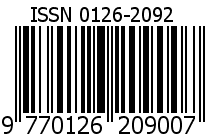UJI RELIABILITAS DIAGNOSIS MIKROSKOPIS MALARIA TENAGA LABORATORIUM PUSKESMAS DI DAERAH ENDEMIK KOTA SAWAHLUNTO SUMATERA BARAT
Abstract
Abstrak
Pemeriksaan mikroskopis masih merupakan diagnosis pilihan untuk malaria karena mudah
dan murah, tetapi kesalahan diagnosis mikroskopik sangat sering terjadi karena kurang
keterampilan dan pengalaman pemeriksa. Penelitian ini bertujuan untuk menilai reliabilitas hasil
pemeriksaan mikroskopis malaria yang dilakukan oleh tenaga laboratorium pada tiga puskesmas
di daerah Sawahlunto; Sei Durian (SDR), Silungkang (SLK) dan Talawi (TLW). Desain
penelitian adalah cross sectional study. Populasi adalah mikroskopis yang terdapat pada ketiga
puskesmas tersebut. Reliabilitas dinilai dengan nilai Kappa yang ditetapkan dengan uji
kesepakatan hasil pemeriksaan dari 3 mikroskopis puskesmas dan satu mikroskopis standar.
Nilai Kappa yang diterima adalah 0,61-1. Reliabilitas diagnosis malaria vivax mikroskopis SDR
dan SLK tidak bisa dinilai karena jumlah malaria vivax sedikit, sedangkan reliabilitas diagnosis
mikroskopis TLW bernilai kurang (Kappa=0,253). Reliabilitas diagnosis falciparum mikroskopis
Puskesmas SDR, SLK, TLW berturut-turut adalah jelek, jelek dan kurang (Kappa 0,022;
0,006 dan 0,200). Sedangkan reliabilitas diagnosis mikroskopis malaria positif dan negatif
SDR, SLK dan TLW adalah berturut-turut jelek, jelek dan sedang (Kappa 0,024; 0,008 dan
0,442). Dari hasil penelitian dapat disimpulkan bahwa kompetensi ketiga mikroskopis tersebut
masih diragukan.
Abstract
Microscopic test is still the best option for malaria diagnostic because of simple and
less expensive. However, fault in diagnosis frequently happen because of lack of skills and
experience. This study determined reliability of microscopic tests conducted by microscopists
in three public health centres in Sawahlunto; SDR, SLK, and TLW. This was a cross sectional
study. The reliability is determined by Kappa value which is stated by agreement test of 3
microscopists of the three public health centres and 1 standardized microscopist. The Kappa
value was 0,61-1. The reliability of malaria vivax microscopic tests of SDR and SLK could
not be determined because of small number of cases, and the reliability of TLW was fair. The
reliability of malaria falciparum microscopic tests of SDR, SLK and TLW were poor, poor and
fair (Kappa value 0,022; 0,006 and 0,200). The reliability based on positivity and negativity of
parasite existence were poor, poor and moderate (Kappa value 0,024; 0,008 and 0,442). This
study concluded that the competencies of microscopists in these three area were questionable.





















